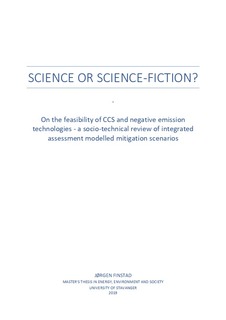| dc.contributor.advisor | Normann, Håkon Endresen | |
| dc.contributor.author | Finstad, Jørgen | |
| dc.date.accessioned | 2019-10-13T10:32:26Z | |
| dc.date.available | 2019-10-13T10:32:26Z | |
| dc.date.issued | 2019-06 | |
| dc.identifier.uri | http://hdl.handle.net/11250/2621766 | |
| dc.description | Master's thesis in Energy, Environment and Society | nb_NO |
| dc.description.abstract | Most climate change mitigation scenarios rely on carbon capture and storage (CCS) and negative emission technologies (NETs) at a very large scale. This thesis takes a critical look at the use and scale of these technologies in the 1.5 °C and 2 °C mitigation scenarios in the IPCC’s special report on Global Warming of 1.5°C (SR15). It provides an overview of the current status of CCS and the various NETs and presents key challenges for these technologies to be deployed at the required scale. This thesis also critically compares the assumptions of the integrated assessment models (IAMs), which are used to develop scenarios, with current knowledge and insights from transition and innovation science. Based on the data and analysis presented, this thesis argues that integrated assessment models miss out on several real-world constraints for the upscaling of technologies. It further argues that CCS and NETs are unlikely to develop and diffuse at the required rate in the real world. By extension, ‘only’ following the trajectories of the scenarios presented in the IPCC’s special report on the 1.5 °C target is unlikely to limit global warming to 2 °C above pre-industrial temperatures, and should be considered a highly risky mitigation strategy. Based on these arguments, the thesis goes on to discuss current weaknesses in mitigation science and suggests potential improvements. It argues mitigation science and strategies are ‘limited’ by current socio-economical paradigms and are failing at assessing the true range of potential mitigation options. For instance, even though we know economic growth is driving emission growth, none of the scenarios in the SR15 explore the mitigation potential of limiting economic growth. More research exploring the mitigation potential of changes in consumption patterns, lifestyles, and broader socio-economic changes is required. Mitigation science also needs to attend more critically to the realism and real-world feasibility of integrated assessment modelled mitigation scenarios. Finally, based on all the aforementioned factors, this thesis argues that – from a risk management perspective – immediate and radical mitigation cuts is the only ‘real’ mitigation option for limiting temperatures to 2 °C above pre-industrial temperatures, and that emission reductions at the scale required is unlikely to be brought about by technological change alone. Instead, it is likely to require changes to the broader socio-economical structures and values of society. | nb_NO |
| dc.language.iso | eng | nb_NO |
| dc.publisher | University of Stavanger, Norway | nb_NO |
| dc.relation.ispartofseries | Masteroppgave/UIS-SV-IMS/2019; | |
| dc.subject | carbon capture and storage | nb_NO |
| dc.subject | negative emission technologies | nb_NO |
| dc.subject | bioenergy with CCS | nb_NO |
| dc.subject | socio-technical transitions | nb_NO |
| dc.subject | integrated assessment models | nb_NO |
| dc.subject | sustainability transitions | nb_NO |
| dc.subject | mitigation science | nb_NO |
| dc.subject | mitigation scenarios | nb_NO |
| dc.subject | climate change | nb_NO |
| dc.subject | feasibility | nb_NO |
| dc.subject | karbonfangst | nb_NO |
| dc.subject | klimaendringer | nb_NO |
| dc.title | Science or science-fiction? – On the feasibility of CCS and negative emission technologies - a socio-technical review of integrated assessment modelled mitigation scenarios | nb_NO |
| dc.type | Master thesis | nb_NO |
| dc.subject.nsi | VDP::Social science: 200 | nb_NO |
| dc.subject.nsi | VDP::Technology: 500::Environmental engineering: 610 | nb_NO |
